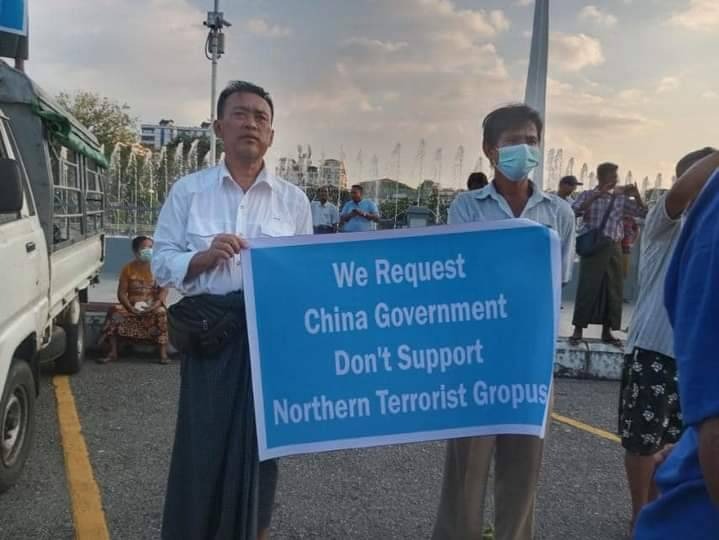There is no doubt that recent events in Myanmar were as unanticipated as they are unprecedented. An alliance of three ethnic resistance armies in the north—the Kokang-based Myanmar National Democratic Alliance Army (MNDAA), the Ta’ang National Liberation Army (TNLA, a Palaung group) and the Arakan Army (AA)—has overrun more than 200 junta bases and confiscated huge quantities of weapons. Morale among the Myanmar army’s troops is low, and there have been surrenders and even defections. The alliance’s military successes in the north have encouraged other resistance forces across the country to be more active, and the Myanmar army seems to be losing ground everywhere. Myanmar appears to be ablaze with resistance to the junta, the State Administration Council (SAC), which seized power in Naypyitaw in February 2021. But is this really going to lead to the downfall of the SAC and the government it appointed, and to the disintegration of the Myanmar army, and put the country on a course to the federal democracy that many see as the final goal of the resistance?
Some, among them Zachary Abuza, a professor at the National War College in Washington, seem to believe so; he has even proposed what should be done with the Myanmar military once the resistance has won. Writing for Nikkei Asia on Nov. 29, he suggests that, “First, the Burman-dominated army, known as the Tatmadaw, must be disbanded and rebuilt from scratch.” But he refrains from saying how such a lofty goal should be achieved, or by whom it would be done. Duwa Lashi La, the acting leader of the National Unity Government, which was set up by the resistance after the coup, said in a statement on Oct. 2—before what has been termed “Operation 1027” was launched by the groups in the north—that resistance forces were in control of about 60 percent of the country’s territory. The Economist reported on June 8 that “there are estimated to be over 300 of these People’s Defence Forces (PDFs), with more than 65,000 fighters.” Add another estimated 100,000 or so in Myanmar’s many ethnic forces and the resistance may soon outnumber the Myanmar army, the strength of which, as independent Australian Myanmar scholar Andrew Selth states, is less than the often cited 400,000 and possibly as low as 250,000, or even 200,000.
But, as Selth also states, while the Myanmar army may be spread out on many fronts and unable to defeat the resistance, it remains the most effective and best-armed fighting force in the country. And the bitter reality is vastly different from the optimistic assessments of the situation that many international and local observers have indulged in since Operation 1027 was launched.
There may be around 300 PDFs across the country and at least 20 ethnic resistance armies, and the Myanmar military has been forced to give up large tracts of land not only in northern Shan State, but also in Chin State, Magwe Region and, especially, Sagaing Region in the west. There is heavy fighting in Karenni (Kayah) State and Karen State, and an embattled Myanmar military has been forced to depend on air power because the infantry is shattered and unable to regain control over areas adjacent to the Thai border.

There are, however, four factors which have to be taken into account when making a realistic assessment of the situation. The first would be the strength of the PDFs and the lack of unity among them. According to a report published by the United States Institute of Peace on Nov. 3, 2022, only 60 percent of them are armed, and “mostly with locally produced low-quality arms.” And they are local resistance forces more concerned with controlling their own respective areas. There appears to be little coordination and no common supreme command, and they are not operating in accordance with some well thought out strategy encompassing the entire country.
The second factor would be lack of unity among the ethnic armies. Kachin, Palaung and Shan armies claim more or less the same areas in northern Shan State, and there are also territorial disputes between the Shan and the Wa, and the Shan and the Pa-O. The most powerful of the ethnic forces, the United Wa State Army (UWSA), may have provided the MNDAA, the TNLA, the AA and the Shan State Army of the Shan State Progress Party with weapons, but it still adheres to the ceasefire agreement it struck with the Myanmar military in 1989 and could not be considered part of some overall resistance. In Kachin State, a local ethnic Shan army is siding with the Myanmar military against the Kachin Independence Army, which in turn has little or no influence in Lisu- and Rawang-inhabited areas of northernmost Kachin State. There are several rival Chin armies in Chin State, and the Pa-O in southern Shan State have been involved in fights with the Shan State Army of the Restoration Council of Shan State (RCSS). The RCSS, on the other hand, sticks to its 2015 ceasefire agreement with the Myanmar military and some of its leaders are investing heavily in real estate in southern Shan State. By no stretch of the imagination could it be claimed that Myanmar’s many ethnic armies are a unified force, or even have common interests.
The third factor is the seemingly everlasting unity of Myanmar’s armed forces. The military has been in power, directly or behind the scenes, since 1962 and, despite purges and dismissals, it has not seen any splits or even inner tendencies that could be viewed as embryonic factions. The military has become a powerful state within a state with its own institutions and privileges for its members. And what is happening now is nothing new. The Myanmar military has been under siege many times during the long history of the country’s ethnic and political civil wars, which broke out shortly after independence from Britain in 1948, and it has always persevered in its endeavours, chief of which is to remain the country’s most potent institution. Only a decisive split within the military, or much larger defections than those we are seeing now, would cause it to fall from power. No one can predict the future, but there have so far been no signs of any such infighting, or even serious disagreements, among the officer corps or the rank and file. On the other hand, unexpected things do happen, so nothing could be ruled out.
The fourth factor, which is too often overlooked, is China. Myanmar is of utmost strategic importance to China because it is the only neighboring country that gives it direct and easy access to the Indian Ocean. China also has other interests in Myanmar, such as resource extraction and, most recently, how to deal with the many cross-border scam centers that are bleeding the nation. And, regardless of what the Brotherhood Alliance comprising the MNDAA, TNLA and AA has said in statements, the recent fighting in northern Shan State has more to do with that than any fight for federal democracy. An estimated US$40 billion has flown out of China and into those scam centers, and that at a time when China is facing an internal economic slowdown. The main centers affecting China are located in the UWSA-controlled territories of northeastern Shan State, and in Kokang and adjacent areas to the north. The Chinese can deal with the UWSA, which is heavily dependent on China for trade and supplies of everything from guns to food. The Chinese issued a couple of arrest warrants of prominent UWSA personalities, read the leaders the riot act, and reined them in.

It is a different story in Kokang and other parts of northernmost Shan State. There, the centers are to be found in areas and at localities controlled by SAC-allied, local militia forces. At first, the Chinese put pressure on the SAC to deal with the problem, but apart from deportations of quite a few not especially important people, nothing really happened. The Chinese then sent undercover special branch officers into Kokang, and several of them were killed by the militias—something that really angered the Chinese.
So did China’s security authorities initiate Operation 1027? That is hard to say, but their security services were certainly aware of the plan in advance and did nothing to stop it, and were pleased to see that the alliance attacked several of those centers and forced them to close down. The UWSA has declared that it is “neutral”, but it has supplied the alliance with most of its weaponry. Those weapons are of Chinese origin, and it is hard to believe that the Chinese disapproved of them being handed over to the alliance forces.
Significantly, groups of “patriotic monks” were allowed to demonstrate outside the Chinese Embassy and City Hall in the commercial capital Yangon on Nov. 19. As The Irrawaddy reported the following day, the monks criticized China for backing “an ethnic alliance that has been delivering heavy defeats against regime troops in northern Shan State. Members of the Patriotic Monks Union (Yangon) and Myanmar Nationalist Organization took part in the protest…accusing Beijing of destroying Myanmar by selling weapons to ethnic armed organizations based near the border in northern Myanmar, and to PDF groups.”
What the Chinese made of the protests is not clear, but the generals soon realized that they could not afford to really antagonize China. Thousands of telecom fraud suspects were subsequently handed over to China, and for days after the demonstrations, spokesmen for the SAC proclaimed the junta’s “strong and amicable” relationship with Beijing, saying the ties will only “grow stronger over time.”
The bottom line when it comes to China’s security authorities is that they have leverage, in one way or another, inside Myanmar only as long as the country is weak. They can play the role of being a “friendly neighbor” and “peacemaker” and, at the same time, use a carrot-and-stick approach to get whatever they want from any government that is in power in Naypyitaw: trade coupled with investment and access to the Indian Ocean on the one hand and indirect support for the ethnic armed organizations on the other. If Myanmar ever became exactly what the resistance is striving for—strong, peaceful, democratic and federal—the influence China now has inside Myanmar would be gone. But China does not want the situation to get totally out of hand, either, because that could lead to serious instability in the frontier areas and, most likely, an unwanted flood of refugees across its border. Hence, Chinese troops were dispatched to areas near the border with Myanmar soon after Operation 1027 began making headway.
All of those four factors combined mean that this is a war neither side can win and the situation won’t change until and unless something more unexpected and decisive than Operation 1027 happens. Meanwhile. caught in the middle is the civilian population, which is bound to suffer the most.

















